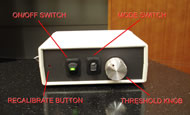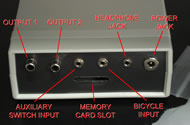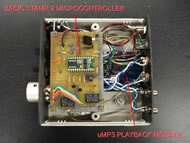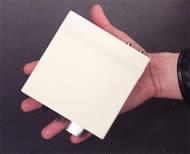Exercise Motivator Device
Turan Kayagil, Matan Setton, Jenny Yuan
Duke University Department of Biomedical Engineering, Durham, NC, USA
ABSTRACT
Exercise is essential for everyone, but for individuals with cognitive disabilities such as autism, it may be necessary to incorporate motivators into supervised exercise regimes. We have developed a device to motivate a stationary bicycle rider to pedal above a threshold speed. Our device links standard bicycles to commercially available assistive technology devices. Pedaling above threshold activates the assistive technology device, which may be a universal remote, a battery interruptor or PowerLink unit, a keyboard emulator, or any other device that accepts a standard switch input. Our device also can provide verbal prompts as feedback. Our device is universal, and can be optimized for different bicycles and users. It may motivate users to maintain exercise for longer uninterrupted periods with less supervision.
KEYWORDS:
Autism, stationary exercise bicycle, assistive technology device.
BACKGROUND
Our primary client is a fourteen-year-old male with autism, attention deficit hyperactivity disorder, and mental retardation. He has been living in a supervised group home for more than a year along with three other adolescent males with autism. The client has no significant motor impairment and has good overall body strength. His supervisors want to incorporate 15-20 minutes of exercise on a stationary bicycle into his daily routine. However, the client loses interest after less than eight minutes on the bicycle, and relies on food and verbal reinforcements from his supervisors while pedaling. The client’s supervisors desire a device that will motivate the client to exercise without food reinforcement, and with less required supervisor intervention. The client’s supervisors also wish the device to be useful for the other members of the group home, as well as to other group homes and facilities. Therefore, the design needs to be efficient and universal, so that its operation can easily be adapted to new situations.
PROBLEM STATEMENT
Our objective was to develop and build a device that would provide incentive and encouragement for sustained exercise on a stationary bicycle. The device preferably needed to be compatible with most bicycles, and had to be adaptable to provide a broad variety of options for what is used as the motivator. The device also needed to be capable of providing verbal prompts in response to sustained above- or below-threshold activity. These prompts preferably needed to be user-recordable. The final design had to be simple, robust, flexible, and universal.
DESIGN
General Approach
 Figure 1: Front panel. Shows recalibrate button, illuminated power switch, mode select switch, and threshold knob. (Click for larger view)
Figure 1: Front panel. Shows recalibrate button, illuminated power switch, mode select switch, and threshold knob. (Click for larger view) To make our device compatible with as many different exercise bicycles as possible, we used the standard reed switch output built in to most stationary bikes as an input to our device to determine pedaling speed. For bikes without the reed switch output, an aftermarket switch can be installed. To make our device capable of providing a variety of motivators, we took advantage of existing commercial assistive technology devices. Such devices allow appliances, toys, computers, media players, and other accessories to be controlled by a standard 1/8” (3.5 mm) mono switch input. Our device plugs into the switch input on these assistive technology devices, and controls the devices in response to pedaling speed.
Hardware
 Figure 2: Back panel. Shows output RCA jacks, jack for auxiliary switch, jack for bicycle, headphone jack, DC power jack, and memory card slot. (Click for larger view)
Figure 2: Back panel. Shows output RCA jacks, jack for auxiliary switch, jack for bicycle, headphone jack, DC power jack, and memory card slot. (Click for larger view) The device is housed in a 5.3” x 5.3” x 2.0” case (Hammond Mfg.). The primary control functions are accomplished by a BASIC Stamp 2 microcontroller (Parallax, Inc.). Prompt playback is accomplished using a uMP3 playback module (Rogue Robotics Corp.). The device inputs include a 1/8” (3.5 mm) mono jack for the bicycle, a 1/8” (3.5 mm) mono jack for an auxiliary switch (described below), an SD flash memory card slot for the MP3 player, and a size N coaxial DC power jack. The outputs include two RCA phono jacks for external device control, a 1/8” (3.5 mm) stereo headphone jack for playing verbal prompts, and a piezo buzzer. Device controls include an illuminated power switch, a mode select switch, a threshold knob, and a recalibrate button to adjust the dynamic range of the threshold knob. The device is powered by a 9 VDC, 300 mA power supply. Appropriate cables are provided for making connections. Total replacement cost of the device is approximately US$275. See Figures 1-4 for images of the Exercise Motivator.
Functions
 Figure 3: Top view without cover. Shows BASIC Stamp 2 microcontroller and uMP3 playback module. (Click for larger view)
Figure 3: Top view without cover. Shows BASIC Stamp 2 microcontroller and uMP3 playback module. (Click for larger view) The stationary bike plugs into our device, and our device measures pedaling speed. Measured speed is compared to a threshold set by the position of a threshold control knob. If pedaling is above threshold, the output is activated. The dynamic range of the threshold knob can be calibrated to a particular bicycle using the reset button on the front of the device. The output “signal” of our device is a switch closure, which may operate external devices that have switch inputs. Our device has two such outputs, which are switched by relays.
The output of our device can be set in one of two modes using a mode switch on the front of the device. In “continuous” mode, output switch 1 is open below threshold and closed above, and output switch 2 is closed below threshold and open above. In “momentary” mode, both outputs are open, but output 1 pulses closed on upwards threshold crossings, and output 2 on downwards crossings. Sustained activity above threshold elicits praise prompts played over the headphone jack, and below-threshold activity elicits encouragement. Prompts are selected randomly from a list, and may be custom recorded on the memory card, which plugs into an accessible slot in the rear of the device. The device also has an auxiliary switch input, which allows an external button to be connected in series with the first output. In continuous mode, the button is active, but below threshold it does nothing. Removing the button automatically returns output 1 to its normal operation.
Suggested uses for our device include the following. Use it in momentary mode with a universal remote (e.g., Adaptivation, Inc.) to pause and play a DVD player, CD player, VCR, or DVR, or to turn a TV or radio on and off. Use the device in continuous mode with a battery interruptor to turn on a favorite battery-operated toy. Use the device in continuous mode with a PowerLink control unit (AbleNet, Inc.) to turn on a radio or other 120 VAC appliance such as a bubble machine (or use the second output to turn on a lamp when pedaling drops below threshold, so activity can be monitored from a distance). Use the device in continuous mode with a keyboard emulator to control the motion of a character through a computer game world (e.g., Island Worlds, by 3D Innovations), or plug in an auxiliary switch and turn pages of a virtual book (e.g., Living Books Software) when above threshold. Alternatively, use the auxiliary switch to turn the pages of a real book (e.g., Flip automatic page turner, AbleNet, Inc.).
Additional Considerations
The power input was designed to work with either center-positive or center-negative polarity. The memory card is a non-dedicated component; any space not taken up by prompts can be used to store other files. The output jacks of our device are of a different style than those of the inputs, people-proofing our design against incorrect hookups. The power switch indicator is a long-life LED. The recalibrate button is recessed to avoid accidental activation, and can be held down to return the device to default calibration. The piezo buzzer annunciates the recalibration process. The device is small, lightweight, and low-profile, has rubberized feet, and is encased in high-impact polystyrene.
EVALUATION
The device successfully measures pedaling speed, appropriately controls outputs to external devices, and plays verbal prompts. The device uses readily available parts and is reproducible. It will be implemented in our client’s group home. Our client’s occupational therapist made the following comments:
This project does an outstanding job of meeting the highly specific activity support needs of this developmentally complex teen. The dual output feature does an excellent job of pairing of meaningful response feedback with a verbal caregiver prompt/support, in a manner that is not intrusive to the involvement in the activity. I am especially excited that the output can be graded to adjust for learning and skill acquisition, as well as be flexible enough to easily use with a wide variety of other items. This unique device has the potential for meeting life-long activity support needs for this individual. I work with many people of diverse ages and disabilities who would greatly benefit from having this device.
Catherine Alguire, MLA, OTR/L
Occupational Therapist and Universal Design specialist
ACKNOWLEDGEMENTS
We thank Richard Goldberg, Kevin Caves, Matt Brown, John Woock, Derek Easley, Catherine Alguire, Alison Rumball, and our client’s mother. We also thank John Bradley of Circuit City (Durham, NC) and Kevin Colbern of 3D Innovations for their generous donations. This work was supported by NSF Grant Number 0118558.
AUTHOR CONTACT INFORMATION
Turan Kayagil
4572 N. 26th Street, Arlington, VA 22207-4154
703-967-4875, turan.kayagil@att.net
